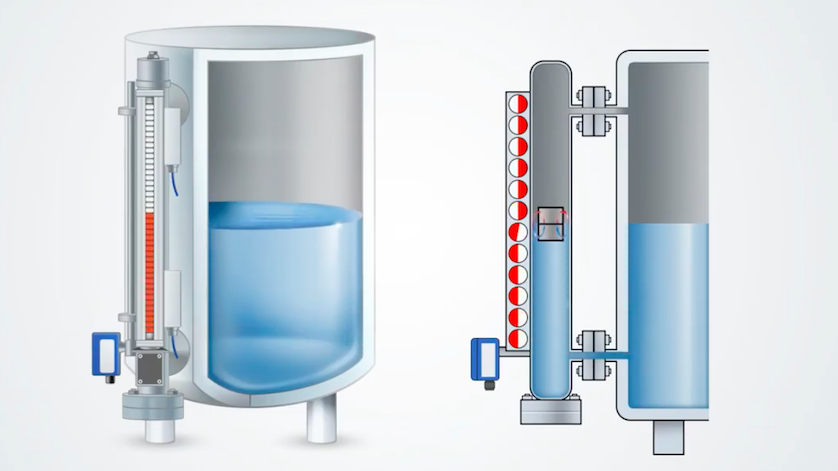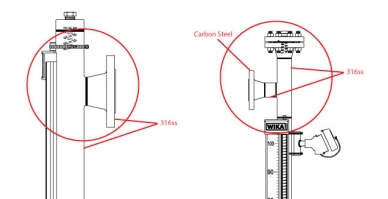
A level gauge’s actual cost often comes down to its flanges. The less expensive the flange material, the less expensive the level gauge. Right? Not always. Other elements factor into the final price, such as the flange rating and whether extra machining and materials are required.
Flanges are a popular way to attach a level gauge to the vessel. The larger the gauge, the larger the flanges will need to be. There’s also the issue of flange rating, which is based on the pressure and temperature limits that the flange can handle.
The cost of a level gauge increases as flange size and its pressure and temperature requirements increase. ANSI (American National Standards Institute) is the most commonly used classification standard in North America, with pressure ratings ranging from 150# to 2500#. The higher the rating, the higher the maximum pressure the flange can withstand. Naturally, the higher the rating of the flange, the more expensive it is.
Some cost engineers automatically choose a cheaper flange material – such as carbon steel instead of the more expensive 316 stainless steel (316ss) – as a way to save money. What they may not be aware of is that different materials have different characteristics and connection requirements; the extra labor and materials will make a big difference in the final cost.
Sometimes it’s cheaper to go with carbon steel (CS) flanges, while other times it’s less expensive – and less of a hassle – to opt for flanges made of 316ss. Let’s take a closer look at these two alloys and how to choose the most cost-effective flange type.
Comparing 316 Stainless Steel and Carbon Steel
Stainless steel is an iron-based alloy with no more than 1.2% carbon and at least 10.5% chromium, which reacts with oxygen to form a protective oxide layer, making it resistant to corrosion. The more chromium and less carbon are in the stainless steel, the more corrosion resistant it is. The addition of nickel gives the alloy its strength and malleability. Other elements include manganese, silicon, copper, sulfur, and more.
A popular type of stainless steel is the 316, which has 2.5% molybdenum, a higher percentage of nickel, and only a very small amount of carbon – about 0.08% – for even greater corrosion resistance. These additions, however, make this type of steel more expensive. 316ss also has an austenite crystalline structure and is nonmagnetic.
Carbon steel, on the other hand, is basically iron with a higher content of carbon – up to 2.1%. CS is stronger and harder than stainless steel, but it has a different crystalline structure and is magnetic. Made of basically just two common elements, it is cheaper to produce than stainless steel.
Minimizing Costs and Maximizing Utility

Because 316 stainless steel is not magnetic, a 316ss flange (left) won’t interfere with a level gauge’s magnetic float. However, when using a flange made of carbon steel (right), which is magnetic, a 316ss space is necessary to prevent magnetic interference.
316ss is extremely resistant to corrosion and, therefore, is the material of choice for parts, such as flanges, that are exposed to aggressive media and high moisture levels. But since this alloy is rather expensive, the cost of the level gauge system can go up sharply when the flange size and the flange rating increase.
One way to reduce costs is to use CS flanges, which can be one-third to one-fifth of the cost of 316ss flanges. But while carbon steel is a cheaper material, it is magnetic. Therefore, when it is located near the magnetic float in the level gauge, the CS flange will pull the float away from the indicator flags. It can even hang up the system.
To overcome the problem with unwanted magnetic attraction in a level indicator, it is necessary to use a 316ss spacer between the flange and the gauge. This spacer ensures that the CS flange does not affect the magnetic float or indicator flags. However, the addition of the spacer means extra machining and welding. This sometimes leads to a more expensive level gauge, but sometimes not.
Cost-effective Solutions for Level Gauges
Design and cost engineers have to look at the bigger picture when selecting which material to use for flanges. Prices* can be very similar once parts and labor are factored in. Let’s take 2-inch flanges as an example, using 2019 prices:
- A 300# 316ss flange costs $57, but it can be directly butt-welded to the branch connection. The final cost: about $97.
- A 300# CS flange costs $21, but it requires a 316ss spacer, which calls for additional machining and welding. The final cost: about $100.
In this case, the 316ss flange wins by a hair. Now let’s double the flange rating.
- A 600# 316ss flange costs $153, but it can be directly butt-welded to the branch connection. The final cost: about $190.
- A 600# CS flange costs $30, but it requires a 316ss spacer, which calls for additional machining and welding. The final cost: about $109.
For flanges with a higher rating, it’s definitely cheaper to use the CS flange, even with the additional material and labor.
Level Gauges by WIKA USA

Model BNA level gauge
WIKA designs and manufactures a variety of float level gauges, including the large Model BNAbypass level indicator with magnetic display. The BNA can be paired with a variety of flange sizes and ratings. To ensure a full penetration weld regardless of the flange material, WIKA uses a unique TIG (tungsten inert gas) welding process that can incorporate a combination of alloys. Our competitors may be capable of the TIG process, but they lack the weld procedures that have been customer approved.
Model BNA is robust and resistant to corrosion, and provides continuous level indication without the need of a power supply. Its range of operating temperatures (−320°F to +840°F / −196°C to +450°C), pressures (vacuum to 5,800 psi / 400 bar), and densities (up to 21 pounds/ft3 / 340kg/m3) make it the ideal solution for chemical and petrochemical applications, as well as for power plants, water treatment units, food and beverage companies, and pharmaceutical plants.
Many variables go into maximizing performance and minimizing cost. Contact a WIKA specialist for more information about level gauges, connection types, flange ratings, and whether it’s more cost-effective to use 316 stainless steel or carbon steel flanges for your application.
* Contact WIKA for the latest prices on flanges, spacers, and labor, which could be higher or lower than the figures listed in these examples.


Please send me price of:
Level indicator With magnetic display Model BNA
Standard version, model BNA-S
Manufacturer: WIKA
Bypass chamber Pmax: 100 bar Tmax: +450 C
Chamber end top: Pipe cap with vent screw ½ NPT
Chamber end bottom: Flange connection with drain valve
Process connections: Standard version Process connections 2 x lateral (1 1/2 inch) class 600
Centre-to-centre distance: 1168 mm
Material Stainless steel 1.4571 (316Ti)
Float Material: Ti Corrugated float Sp.Gravity: 0.793
Magnetic display: High-temperature version: > 200 °C
Hi Ali. Thank you for your comment. A product manager should be reaching out to you shortly regarding your inquiry.
Tank height 14meter
Level Gauge
Hi, feel free to look at our level products. Model BNA or products similar to BNA such as LGG or FLM-S, FLM-T, FLM-P may be what you are looking for. Your inquiry has been passed along to our sales team to provide pricing information and someone should be reaching out to you soon.